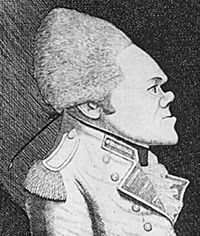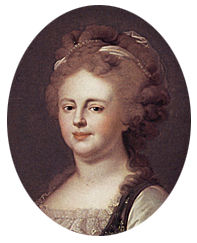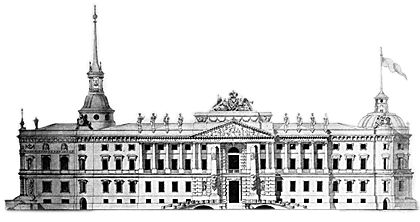
 Left: A cartoon of Paul from the contemporary Britsh press. Left: A cartoon of Paul from the contemporary Britsh press.
The reign of Paul I was very short. Immediately upon assuming the throne he made good his threat to overturn all his mother's policies. He changed Russia's long standing alliances with foreign powers and pursued personal vendettas against his mother's ministers and friends, whom he humiliated and exiled. In the first 24 hours of his reign Paul issued degress outlawing waistcoats and outlining, by Imperial decree, the sizes of people's hats and the style of their shoes. Foriegn books were no longer allowed to be imported and the Emperor even decided how many people could be invited to a party.
Paul was obviously unstable; he shouted at people who moved too fast or too slow, he whipped and struck people who displeased him. The Winter Palace in Petersburg took on the appearance of a fortress or prison with soldiers dressed in Prussian uniforms closely spaced around the building. Paul spent much of his time drilling his troops and imposing physical punishment for the slightest infraction of his rules. The Tsar was fascinated with the order of the Knights of Malta - an island far away in the Mediterranian Sea - and became the Grand Master of this Catholic order. When Malta was seized by England he immediately became England's enemy - in opposition to the interests of Russia - and began plans to invade British India in revenge. Russia was in a state of chaos.
 Right: Paul I's wife Maria. Right: Paul I's wife Maria. No one could control Paul. His wife, a German princess who assumed the name of Maria in Russia, was afraid of him and her influence had been undermined by court intrigue. Paul's mistress, Catherine Nelidova, was also in trouble with him and at one time he was not speaking to either of them except to warn them that he planned to replace them both with a new younger mistress.
Paul built himself an entirely new place in Petersburg, which he christened the Mikhailovsky Castle. The building was designed by Brenna and Paul rushed the construction so he could move in as soon as possible. The building was built like a castle, with a moat and five drawbridges. Paul knew he was hated and that people were conspiring against him. The new palace with its heavy security was intended to increase his safety; with good reason, for plans were afoot to remove him from the throne.
Paul moved in despite the fact the walls were still damp and sweating, filling the rooms with mildew and a fog-like atmosphere. Here Paul was told that a major conspiracy had been uncovered to overthrow him. Paul summounded the Governor-General of St. Petersburg, Count Pahlen, for information on the conspiracy - not knowing that the Count was himself one of the ring-leaders of the plot. Pahlen was smart enough to lie to the Tsar telling him that he had joined the conspiracy in order to unmask it. Paul demanded details of the plot and the names of all of those involved - Pahlen asked for 48 hours to put together a comprehensive list and got it. Paul next asked if his two oldest sons, Alexander and Constantine, were also involved. Pahlen told him no. That was another lie. Alexander was deeply involved.
 Above: The Mikhailovsky Castle. That very same day Pahlen and his fellow conspirators quickly put into play their plans to depose Paul. At night they smuggled themselves into the Mikhailovsky Castle and made their way to Paul's bedroom, where they found the Tsar hiding behind a firescreen. In the following minutes a group of five of the conspirators, who were drunk, began to chase Paul around his writing desk. The Tsar tripped and fell to the floor where upon he was pounced on and an attempt was made to strangle him with a scarf, which broke. Pleading for his life Paul was then killed with a heavy paperweight made of gilt bronze and malachite.
At his death Paul was only 47 and he had reigned for four short years. He was succeeded by his son, Alexander I, who, though he was not present at his father's murder, had approved of the plot to overthrow him. Alexander's mother never forgave him for his role in the murder and made a point of reminding him of it in many subtle ways. At Pavlovsk she often received her son in front of the firescreen his father had attempted to hide behind when he was killed, the fatal paperweight on the table alongside her as yet another reminder.
Alexander I reopened Tsarskoe Selo and made the Catherine Palace his principal summer residence. He refurbished the interiors and restored the park to its'former glory. Alexander had no sons and his designated heir was his younger brother Nicholas I. He gave Nicholas the use of the Alexander Palace, which thereafter was used informally as the Tsarevich's - Crown Prince's - residence in Tsarskoe Selo.
After Alexander I died in 1825 his rooms in the Catherine Palace were preserved as he had left them as a shrine to his memory. These rooms, attached to the private rooms of Catherine the Great, became a museum of sorts. Nicholas I continued to use the Alexander Palace as his residence in Tsarskoe Selo and the Catherine Palace was mostly used for ceremonial purposes. The Tsar also converted one of the halls, seen at the top of this page, as a gym and exercise hall for himself and his family. The huge slide on the right was meant to amuse the children on days when they were unable to play in the park. A similar "Mountain" - slides are called "Mountains" in Russia- was also built in the nearby Alexander Palace. The tall bars on the left were used for climbing.
In 1900 the Tsar was no longer living in the Catherine Palace and the palace was open on certain days for tours. Tourists from all over the world came to Tsarskoe to see the palace and go through its rooms. Tickets were purchased from a special office. Tourists were able to visit all of the formal rooms and many of the private rooms, where the personal items belonging to former Tsars and Tsarinas were on display. They could see the wonders of the Amber Room, the Great Throne Room as well as the private bedroom of Alexander I with his clothes still scattered about as if he were to return at any moment. Tourists were often surprised to see such examples of everyday life - including the gym - since the Tsars were virtual demi-gods and not thought of in terms of slides, chinning bars and the sight of pairs of well-worn boots set alongside chairs and tables laid out casually with socks, gloves and hats.
Next photograph: A Magic Dining Table
For a small map of the St. Petersburg area click here.
To see a large map of the center
of St. Petersburg go here.
Comments on the website should be sent to Bob
Atchison. | 
